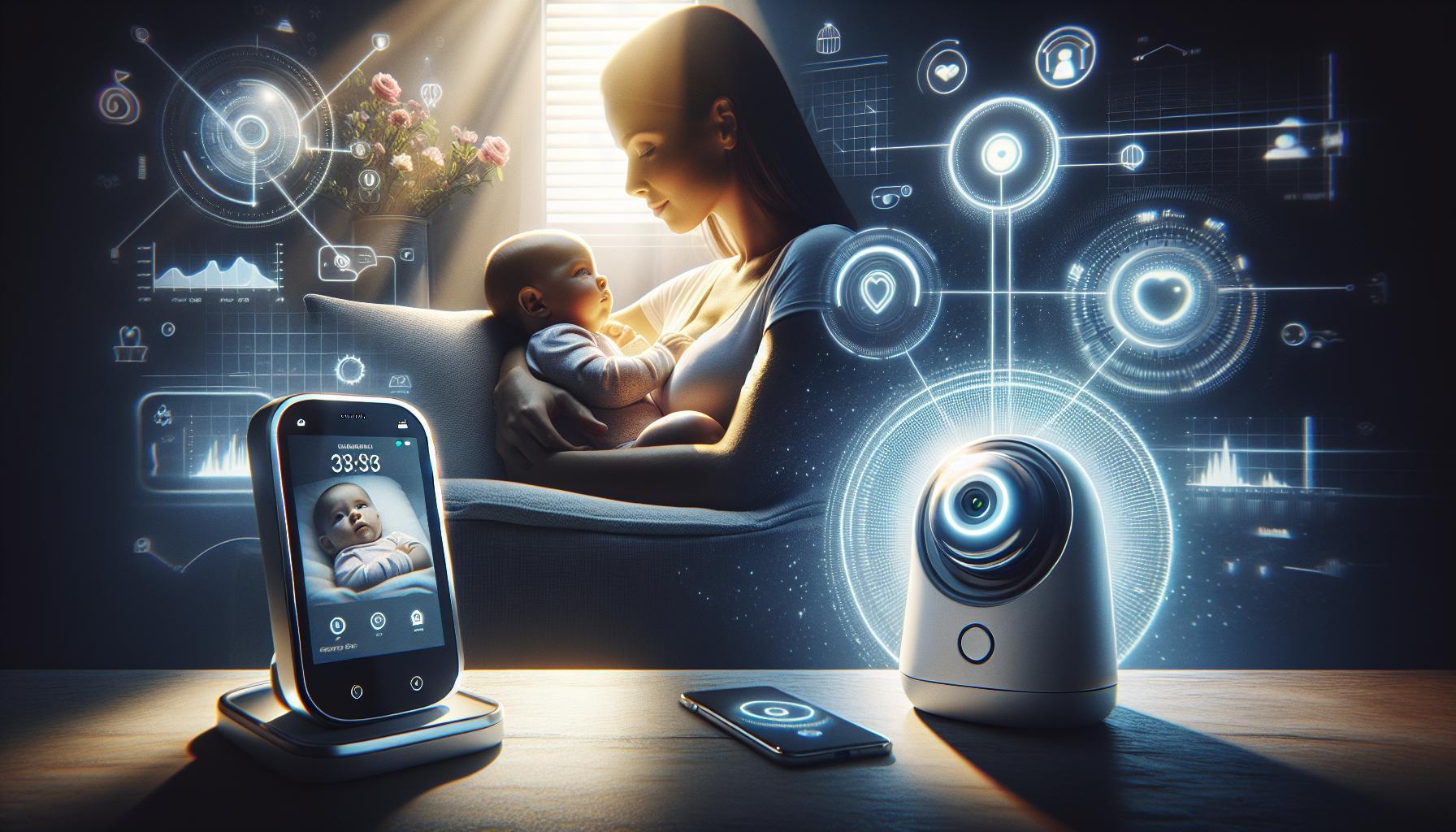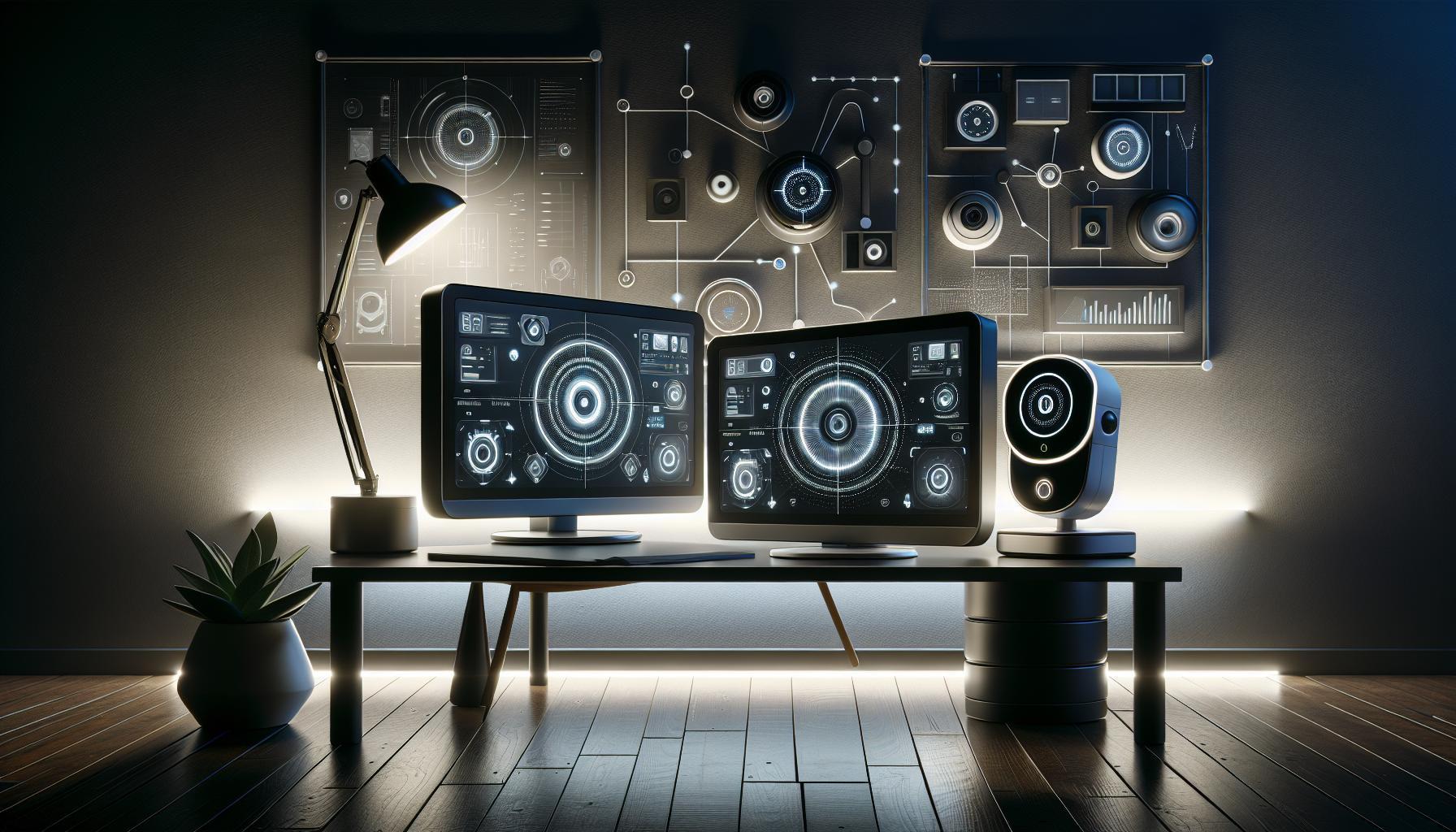Choosing the right type of monitor for yoru baby’s nursery can be daunting, especially with the debate between audio and visual options. Understanding the unique benefits of each can substantially impact your peace of mind and your child’s safety.This guide explores whether a video monitoring system is essential, helping you make an informed decision based on your needs and lifestyle.
understanding the Basics: What Is a Baby Monitor?
What Is a Baby Monitor?
In an age where technology is woven into the very fabric of parenting, understanding the fundamentals of a baby monitor is essential. A baby monitor serves as a lifeline between you and your little one, allowing you to maintain a safe environment while giving you the freedom to move around your home. These devices come in different forms—from simple audio systems to advanced video monitors—enabling parents to stay connected without being in the same room.
Baby monitors primarily fall into two categories: audio and video. Audio baby monitors capture sound, allowing parents to listen to their baby’s cries, coos, and even the moments of silence that might signal sleep. On the other hand, video baby monitors enhance this experience by offering a visual feed, providing peace of mind that’s often sought after in caring for an infant.
- Audio Monitors: These devices transmit audio signals so you can here your baby while in another room.
- Video Monitors: These come equipped with cameras that allow you to see your baby in real-time, often with added features like night vision.
Features to Consider
When debating the question “Do I need video monitoring?” it’s essential to weigh the features each type of monitor offers.
| Feature | Audio Monitors | Video Monitors |
|---|---|---|
| Real-Time Audio | ✔ | ✔ |
| Video Feed | No | ✔ |
| Temperature Monitoring | Some models | ✔ |
| Mobile Alerts | No | ✔ |
Ultimately, the choice between audio and visual baby monitors hinges on your unique parenting style and the environment in which you’ll be using them. Understanding the key functionalities of these devices can transform your parenting experience, allowing you to make an informed decision that aligns perfectly with your family’s needs.
The Pros and Cons of Audio vs. Video Monitoring
When deciding on the best way to keep an eye on your little one, the choice between audio and video monitoring can feel overwhelming. Each option boasts unique benefits and drawbacks. Understanding these can help parents make an informed decision aligned with their needs.
Benefits of Audio Monitoring
Audio baby monitors have long been a trusted choice for many parents. Here are some advantages that make them appealing:
- Cost-Effective: Audio monitors are typically much cheaper then their video counterparts, making them a budget-amiable option.
- Simplicity: These devices are generally easier to set up and use. they often come with just a few buttons and straightforward instructions.
- Batteries Last Longer: Without the need for video streaming, audio monitors tend to have extended battery life.
- Less Distraction: With audio-only alerts, parents can focus on other tasks without being visually distracted by a monitor.
drawbacks of Audio Monitoring
While there are many advantages to audio monitoring, some limitations can affect its efficacy:
- Limited Visibility: audio monitors do not allow parents to visually check on their babies, which can lead to anxiety and uncertainty, especially in new parents.
- Missing Visual Cues: Parents may miss essential visual cues related to their baby’s comfort or safety, such as signs of distress or when they’ve rolled over.
Pros of Video Monitoring
Video monitors are becoming increasingly popular due to their parents’ desire for enhanced security and peace of mind. consider these benefits:
- Visual Confirmation: The ability to see your child can alleviate worries. Parents can visually confirm their baby’s safety, ensuring they are sleeping soundly or are in distress.
- Detailed Monitoring: Many video monitors offer zoom functions or infrared night vision, allowing for clear monitoring even in low-light conditions.
- Multi-Functionality: Some models come equipped with features like temperature gauges and two-way communication, adding versatility to the device.
Cons of Video Monitoring
Despite their benefits, video monitors aren’t without disadvantages:
- Higher Costs: Video monitors can be significantly more expensive than audio-only options, which may not be feasible for all families.
- Complexity: The technology involved can be overwhelming, especially for parents who prefer straightforward devices, and set-up may involve more steps.
- Battery Drain: Because video monitoring requires constant visual feedback, battery life may be shorter compared to audio-only models.
Ultimately,the decision of whether to invest in audio or video monitoring can be simplified by considering the specific needs of your family. For example, families with multiple children may find video monitors helpful for keeping an eye on several kids at once. Conversely, if you’re searching for something simple and economical, traditional audio monitoring might suffice. By weighing the pros and cons of each type, you can ensure that your choice aligns with your parenting style and lifestyle preferences.
Key Features to Look for in Baby Monitors
Understanding Essential Features in Baby Monitors
Choosing the right baby monitor goes beyond merely deciding between audio and video capabilities. The right monitor can significantly enhance your peace of mind while ensuring your baby’s safety.When exploring options,consider these key features that can make all the difference in your monitoring experience.
Video Quality: In a world where clarity matters, opting for a monitor with high-definition video is crucial. A minimum of 720p HD resolution is preferable, as better video quality makes it easier to discern your baby’s movements and expressions. Look for monitors that offer night vision capabilities, allowing you to keep an eye on your little one even in a dimly lit room.
Audio Features: While video monitors provide a visual connection, don’t overlook the importance of superior audio quality. Two-way audio capability enables you to communicate with your baby without having to be in the same room. This feature can be comforting for both you and your baby, especially if they wake up and need reassurance.
Range and Connectivity
The effective range of a baby monitor is vital, especially in larger homes. Many modern monitors utilize WiFi connectivity for extended range. Always check the specified distance, as some devices can reach up to 1000 feet outdoors, which is ideal for multitasking parents.
| Feature | Importance |
|---|---|
| Video Quality | Clear images for monitoring; essential for night vision |
| Audio Features | Two-way communication; enhances comfort and reassurance |
| Range | Ensures connectivity throughout the house; ideal for larger homes |
| Smart Features | Integration with apps for remote monitoring; convenience for busy parents |
Additional Smart Features: In today’s digital age,many baby monitors offer smart-home integration,allowing you to monitor your baby remotely via smartphones or tablets.This connectivity provides real-time alerts and updates, ensuring you are always in tune with your baby’s needs — whether you’re in another room or even outside the house.Understanding these key attributes is essential when deciding,as they can significantly influence your monitoring experience. Take the time to assess your specific needs and preferences, and you’ll find the perfect device to keep you connected with your baby.
Addressing Your Privacy Concerns with Video Monitors
Understanding Privacy with Video Monitors
in today’s digital age, the thought of surveillance, even within the familiar confines of your home, can evoke concerns about privacy. When considering video monitoring options, such as those detailed in the exploration of audio vs. visual baby monitors, it’s essential to weigh not only the functionality but also how these devices impact your privacy. An alarming fact reveals that compromised privacy can lead to meaningful distress, especially for families with vulnerable members.
How Video Monitors Can safeguard or Compromise Privacy
While video monitors provide peace of mind by allowing parents to visually check on their children, they can also introduce potential privacy risks if not properly managed. Here are some critical points to consider:
- Security Risks: Video monitors can be susceptible to hacking, especially if connected to the internet. It’s crucial to choose models with strong encryption and regular firmware updates to mitigate these risks.
- Informed Consent: If your video monitor captures footage of shared spaces, it’s crucial to communicate with household members about the monitoring. This fosters a respectful environment and ensures everyone is aware of potential surveillance.
- Data Protection: Operational practices like secure password settings and data storage options should be prioritized. Ensure that any recorded data is stored securely and accessible only to authorized individuals.
Best Practices for Using Video Monitors Responsibly
Taking proactive steps can drastically enhance your privacy while using video monitors. Here are actionable strategies:
| Best Practices | Description |
|---|---|
| Secure Your Network | Use a secure Wi-Fi password and consider setting up a guest network for visitors. |
| Choose Trusted Brands | Research and select reputable brands known for their commitment to user privacy and security. |
| Limit Access | Only provide access to trusted family members or caregivers, and revoke access when no longer necessary. |
| Regularly Update | Keep your device’s software up-to-date for the latest security features and fixes. |
By following these guidelines,you can maximize the benefits of video monitoring for your family while maintaining a focus on privacy. Understanding and implementing efficient privacy measures will allow you to enjoy the peace of mind that video monitors offer without compromising your family’s personal space.
Setting Up Your Baby Monitor: Tips for New Parents
Setting up a baby monitor can feel like a daunting task for new parents,especially with the plethora of options available today. Understanding where and how to position your monitor can significantly enhance your peace of mind, allowing you to keep a watchful eye (or ear) on your little one while they sleep or play.
Choosing the Right Location
One of the first steps in setting up your baby monitor is selecting the optimal location for placement. Ideally, the monitor should be close enough to capture clear audio and video but positioned out of your child’s reach to prevent any tampering. Here are some key tips for placement:
- Height Matters: Mount the camera or place the monitor at a height that gives you a extensive view of the crib while avoiding any obstructions.
- Direct Line of Sight: Ensure there are no furniture pieces or toys in the way of the camera’s line of sight to maintain a clear view of your baby.
- Avoid Crib Proximity: place the monitor at least 3 feet away from the crib to avoid any risk of the baby reaching it.
Understanding the features
in your quest to determine whether video monitoring is right for you, familiarize yourself with the different features that modern monitors offer. Some additional features to consider include:
| Feature | Benefits |
|---|---|
| Two-Way Audio | Allows you to soothe your baby with your voice without needing to enter the room. |
| Night Vision | Ensures visibility in low-light conditions, crucial for nighttime monitoring. |
| temperature Sensors | Keeps you informed about the nursery’s temperature, helping you maintain a cozy environment. |
By understanding these features, you can make a more informed decision on the type of baby monitor that will best suit your lifestyle. Consider what is most essential for your family’s needs as you ponder the myriad ways to keep an eye on your little one, all while contemplating the question: “Do I need video monitoring?”
Testing the Setup
Once you’ve selected your monitor and established the best location, it’s time to test the setup to ensure everything functions properly. Before your baby arrives, spend some time getting acquainted with the device’s features. Test the audio and video quality by moving around the house, ensuring your monitor’s signal remains strong. Additionally, check the battery life if you’re using a portable device. A reliable monitor can provide parents with the reassurance they need, leaving them wondering less about the effectiveness of their choice between audio and video monitoring options.
Ensuring Safety: Security Measures for Video Monitoring
Prioritizing Security in Video Monitoring
In today’s digital age, ensuring the safety of your loved ones is a top priority, especially when it comes to using video monitoring systems for infants.While audio monitors offer some level of reassurance, video monitors provide a visual connection that can enhance your ability to respond to your child’s needs promptly and safely. However, with this capability comes the responsibility of implementing adequate security measures to protect your footage and privacy.
To begin with, selecting a video monitor that offers robust security features is essential. Look for models that employ strong encryption methods to safeguard data transmitted from the camera to your device. features such as password protection and two-factor authentication are critical in preventing unauthorized access. Additionally, regular firmware updates from the manufacturer are vital, as they often contain important security patches to combat evolving threats.
- Use Strong Passwords: Create unique passwords for both your monitoring device and the connected app. Avoid common words and include a mix of letters, numbers, and symbols.
- Disable Unused Features: If your video monitor has capabilities that you don’t use (like remote viewing), consider disabling them to reduce potential vulnerabilities.
- network Security: Ensure that your home Wi-Fi network is secured with WPA3 encryption and regularly change the wi-Fi password.
Regular monitoring and awareness
another critical element of security in video monitoring is staying proactive. Parents should routinely check who has access to the monitor and conduct periodic reviews of the footage if possible. This oversight can definitely help detect any unusual activity or unauthorized individuals accessing the device. Furthermore, utilizing video monitoring systems that offer cloud storage with secure access enhances your ability to retrieve data while providing peace of mind.Here’s a simple checklist to enhance your video monitoring security:
| Security Measure | Description | Frequency |
|---|---|---|
| Change Password | Update passwords for the device and application. | Every 3-6 months |
| Update Firmware | Check for manufacturer updates regularly. | Monthly |
| audit Access | Review user access on the device. | Quarterly |
By proactively implementing these security measures, you can ensure that your video monitoring setup not only provides comfort but also enhances the safety and security of your child. As advancements in technology blossom within the realm of baby monitors, incorporating these strategies will empower you to make informed choices, reinforcing the value of safe monitoring solutions as discussed in “Do I Need Video Monitoring? Comparing Audio vs. Visual Baby Monitors.”
Real-Life Scenarios: when Video Monitoring Really Makes a Difference
Imagine this: it’s a quiet afternoon, and your little one is peacefully napping in their crib. As a parent, the ability to visually check on them without disturbing their sleep is invaluable.This is where video monitoring steps in,providing a crucial layer of reassurance that traditional audio monitors simply cannot match. The visual feedback allows parents to identify whether their child is asleep, fidgeting, or having a restless moment—all without physically entering the room.Enhanced Peace of Mind
In situations where safety is paramount, such as monitoring children near swimming pools or busy play areas, video monitors shine. Parents can keep an eye on their kids while preparing lunch or managing household tasks, ensuring that help is just a glance away. The visual aspect allows for rapid assessment of situations that may require immediate intervention, something that audio-only devices may miss. Here are some specific benefits of video monitoring in these scenarios:
- Immediate Visual Assessment: Quickly view if your child is in distress.
- night Vision Capability: See your child clearly during nighttime hours.
- Interaction Opportunities: Communicate with your child through two-way audio features.
Common Scenarios Benefiting from Video Monitoring
Consider a scenario when a toddler has learned to climb out of their crib. A visual monitor can alert caregivers to this potential hazard before an unexpected fall occurs. Families can also use video monitoring to keep tabs on older children as they play alone,providing peace of mind while allowing freedom for independence. In both cases, parents benefit from knowing they can respond quickly to any situation, whether it’s a simple call for help or a more serious issue.
Additionally, video monitoring can facilitate the care of children with special needs who may require closer observation. for parents managing complex health conditions, having the ability to both hear and see their child can make a significant difference in day-to-day life, offering both data and peace of mind during critical moments. With the right setup, these monitors become indispensable tools that transcend mere convenience, offering safety and comfort to both parents and children.
the decision to explore options such as video monitoring is often influenced by the unique situations families find themselves in, contributing to the ongoing conversation around whether to choose audio or visual baby monitors.
Expert Recommendations: Choosing the Right Monitor for Your Family
Understanding Your Family’s Needs for a Monitor
When considering the right monitor for your family, it’s essential to understand the various options available and how they cater to different needs. For instance, a video monitor can provide real-time visuals of your baby, allowing you to see not just hear what’s happening in their nursery.This is particularly useful for parents who want to maintain a sense of connection while multitasking around the house. In contrast, audio monitors tend to be more budget-friendly and may suffice for families who are nearby or prefer a minimalist setup.
Key Features to Consider
When examining the question “Do I Need Video Monitoring? Comparing Audio vs. Visual Baby Monitors,” here are several factors to guide your decision:
- Range: Ensure that the monitor covers the distance between rooms in your home.
- Night Vision: For video monitors, check if they offer night vision capabilities for low-light conditions.
- Tilt and Zoom: Some video monitors allow remote adjustments, enabling you to get a closer look at your child without entering the room.
- Mobile Access: Many modern monitors come with apps that let you check in from your smartphone, offering peace of mind when you’re away from home.
Choosing the Right Type
To make an informed choice, assess your family’s preferences and lifestyle.Here’s a comparison table that illustrates key differences between audio and visual monitors:
| Feature | Audio monitors | Video Monitors |
|---|---|---|
| Visual Feedback | No | Yes |
| Price | Lower | Higher |
| Battery Life | Longer | Shorter |
| Portability | Very Portable | Less Portable |
Evaluating these features will ultimately enable you to choose a monitor that aligns with your family’s habits and preferences. By thoughtfully considering the question “Do I Need Video Monitoring? Comparing Audio vs. Visual Baby Monitors,” you can ensure peace of mind and add an extra layer of security as your little one grows.
Q&A
Do I Need Video Monitoring? comparing Audio vs. Visual Baby Monitors?
Whether you need video monitoring depends on your comfort level and parenting style. Video monitors provide a visual check, while audio monitors alert you to sounds. If watching your baby closely gives you peace of mind, video monitoring might potentially be ideal.
Consider your home’s layout, your baby’s sleeping habits, and your personal preferences. Video monitors frequently enough come with features like night vision and two-way communication, which can enhance your monitoring experience.
What are the advantages of a video baby monitor?
Video baby monitors offer several advantages, including the ability to see your baby while they sleep. This gives parents the visual confirmation that audio alone cannot provide, allowing you to notice subtle movements or changes.
With features like zoom, night vision, and the option to pan and tilt, video monitors can help you keep a closer eye on your baby. Additionally,many devices include smartphone integration,enabling you to check in no matter where you are in your home. For a deeper dive into these features, check our full guide on baby monitors.
Why does audio monitoring still remain popular?
Audio monitoring remains popular because it is generally more affordable and less intrusive than video options. Many parents appreciate the simplicity and ease of use associated with audio monitors, allowing them to listen for their baby’s needs without being distracted by video.
Additionally, audio monitors are less likely to raise privacy concerns.They are a solid choice for those who prefer minimal tech or who believe their baby’s sleep environment should remain less monitored.
Can I use both audio and video monitoring together?
Yes, you can absolutely use both audio and video monitoring together for enhanced security. This combo allows you to enjoy the benefits of each type: visuals with video and alerts with audio.
This mixed approach can be especially useful during nighttime or nap times,where sounds might wake you up before you can check visibly. Using both types of monitors gives you comprehensive coverage and peace of mind as a parent.
Are video baby monitors safe for my baby?
Yes, video baby monitors are safe for your baby when used properly.Ensure the monitor is set up according to the manufacturer’s instructions to avoid any possible hazards.
Additionally,consider using wireless monitors with secure networks to prevent unauthorized access. Regularly check for firmware updates to keep your device secure. The safety of your baby comes first, so always prioritize security features.
How do I choose between an audio and a video monitor?
Choosing between an audio and a video monitor depends on several factors, including your budget, the size of your home, and your monitoring needs. If you want to see your baby’s movements, a video monitor is best.
However, if you prefer a cost-effective and simple solution, an audio monitor may suffice. Evaluate your priorities as a parent—whether it’s budget, usability, or comfort—when making this decision.
What features should I look for in baby monitors?
When selecting baby monitors, consider features like night vision, battery life, and range. Additional functionalities like lullabies, temperature displays, and two-way audio can enhance usability.
if you opt for a video monitor, features such as remote viewing via a smartphone app may also be important. Always check customer reviews and ratings for insight into performance. For further assistance on feature comparisons, refer to our comprehensive guide.
To Wrap It Up
choosing between audio and video baby monitors is an important decision that hinges on your family’s unique needs.Video monitors offer added visual reassurance, allowing you to see your baby and assess their environment, while audio monitors can provide simple, effective communication. Remember to consider factors like setup, security, and privacy to ensure you select the right option for your household.
as you navigate this decision,take the time to explore different brands and features that best align with your lifestyle. Engaging with other parents or reading user reviews can also provide valuable insights. Ultimately, prioritize what makes you feel most secure and connected to your little one. Should you have more questions or want to share your experiences, feel free to reach out or dive deeper into other articles. Your peace of mind and your baby’s safety are the top priorities!






